Sunday, April 30, 2006
Your questions, answered!
Through the magic of SiteMeter and Tracksy, I can sometimes see what people who visit my site have been typed into search engines to get here. And sometimes I can tell I really didn't answer their questions here on this blog. So, I'm starting a new feature. At the end of the month, I'll go through my referral logs and see what people who visit my site have been searching for, and I'll answer some of the more interesting - or useful - questions that I find in the logs. Here are some questions, based on what you, the readers, have typed into search engines.
I want to put a wing on my car. Do I have to weld it on?
No. While some OEM wings, such as the one on the Plymouth Superbird, attach to hard points welded to the subframe, virtually all aftermarket wings are designed to bolt in place. Some even attach to the mounting holes already drilled for a factory wing or spoiler.
How do I remove a slant six intake manifold?
It's easiest to remove the intake and exhaust manifold in one operation. Once you unbolt the exhaust headpipe (two bolts, or studs, depending on the year) and the carburetor (two to four bolts), you just have to deal with the set of bolts holding the manifold assembly to the cylinder head. All but one of them are straightforward. Unfortunately, there is one hidden under the choke pocket that is notoriously hard to reach or even see. Most of the time, if the manifolds don't come off with a firm pull, it's because of that one ellusive nut. Note that re-installing it usually requires loosening the three bolts that hold the two manifolds together, but you don't need to deal with these to remove the assembly.
Is it possible to use windshield washer fluid as a fuel?
Not directly; it's typically about 95% water. There is a substantial bit of methanol in it, but separating it is going to be a pain. And it's an absurdly expensive way to get a fuel, as it works out to over twenty bucks for a gallon of pure methanol even if you can separate it without paying anything.
I want to put a wing on my car. Do I have to weld it on?
No. While some OEM wings, such as the one on the Plymouth Superbird, attach to hard points welded to the subframe, virtually all aftermarket wings are designed to bolt in place. Some even attach to the mounting holes already drilled for a factory wing or spoiler.
How do I remove a slant six intake manifold?
It's easiest to remove the intake and exhaust manifold in one operation. Once you unbolt the exhaust headpipe (two bolts, or studs, depending on the year) and the carburetor (two to four bolts), you just have to deal with the set of bolts holding the manifold assembly to the cylinder head. All but one of them are straightforward. Unfortunately, there is one hidden under the choke pocket that is notoriously hard to reach or even see. Most of the time, if the manifolds don't come off with a firm pull, it's because of that one ellusive nut. Note that re-installing it usually requires loosening the three bolts that hold the two manifolds together, but you don't need to deal with these to remove the assembly.
Is it possible to use windshield washer fluid as a fuel?
Not directly; it's typically about 95% water. There is a substantial bit of methanol in it, but separating it is going to be a pain. And it's an absurdly expensive way to get a fuel, as it works out to over twenty bucks for a gallon of pure methanol even if you can separate it without paying anything.
Nuts can drive you crazy
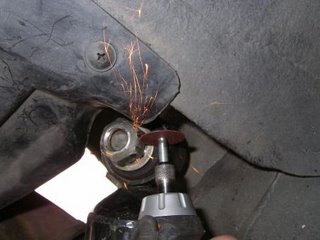 My wife and I switched cars for last week so I could haul some things back from my house before it sold. Her Nissan Pathfinder had a problem with the rear suspension shaking, like a giant hand had grabbed the rear bumper. A little bounce test suggested that the rear shocks were toast. So I figured that was the problem. Looked like an easy enough job - they're only held on with one nut at the top and one bolt at the bottom. You don't even have to lift up the car to get to them. I bought a pair of Monroe Sensatracks from Pep Boys and went to work.
My wife and I switched cars for last week so I could haul some things back from my house before it sold. Her Nissan Pathfinder had a problem with the rear suspension shaking, like a giant hand had grabbed the rear bumper. A little bounce test suggested that the rear shocks were toast. So I figured that was the problem. Looked like an easy enough job - they're only held on with one nut at the top and one bolt at the bottom. You don't even have to lift up the car to get to them. I bought a pair of Monroe Sensatracks from Pep Boys and went to work.Well, remember what I said about working on the suspension? Road grime and water are bad for threads, and there's always a stuck fastener in every suspension job. In this case, the nut at the top somehow got into a situation where I could turn it but it wouldn't come off. Hoping that there was a way to salvage things, I asked on the Grassroots Motorsports board, but the response was pretty much unanimous: The nut was stripped, and the only way to get things finished was to destroy the nut. So I sliced it in two with a cut-off wheel and a chisel.
As you can see, the nut was missing a considerable length of thread. I also had to hack off a short length of the stud, which had equally damaged threads. Luckily, there's still enough left to hold on the replacement nut.

Unfortunately, while the new shocks seem to damp out a bit of the vibration, the problem is still there. Seems like there was some other issue and the blown shocks made it worse.
Saturday, April 22, 2006
Mileage tips
I've dedicated a lot of blogging to gas mileage devices that don't work. This time, I'll pass on a few tips about gas mileage that might actually work. However, I would like to start with a few words of caution. Not all of these tips might work for all cars, and there are some scammers that have been known to take up one or two of these principles and use it for dubious ends. In some cases, the mileage gain may be so tiny as to be unmeasurable. All that I can promise is that the theories behind them are sound and BS-free. Here are some tactics that might save you some gas. I don't have anything here where you can get a $69.95 part, install it in a few minutes, and improve your milage by 25%, but I don't believe anyone who actually claims that, either. These tips either make only minor improvements, or require heavy wrenching and starting with an older car that gets pretty bad mileage as it is.
1. Keep you car in good working order.
If you have worn spark plugs, a failing oxygen sensor, or other problems, your car probably won't get its best gas mileage.
2. Check the tires.
Low pressure is the biggest one. If you pump them up to the maximum allowable pressure - as indicated on the tires, not what's recommended in the owner's manual - you will cut down on friction. Some people will tell you this may screw up the ride or handling. The ride will be harsher, but it's not likely to ruin the handling. Many street tires deliver maximum grip when inflated well beyond recommended pressures anyway. I've raced on tires inflated to 40 psi - not that you should drive with your tires inflated like this on the street, but I have to say it didn't give my car any treacherous handling quirks. Be careful if you pump up the tires to the maximum pressure on the sidewall when they're cold, though, as the pressure increases when they heat up.
If you're in the market for new tires, consider ones meant for low rolling resistance. These will cut down on friction a little.
3. Good lubricants.
Different oils produce different amounts of friction. The thinner the oil, the less friction, so using the thinnest grade of oil your owner's manual recommends for you climate can help out. Look for API's "Energy Conserving" or "Energy Conserving II" symbol - oil manufacturers can't legally use this unless they have demonstrated to the American Petroleum Institute that their oil can improve gas mileage compared to oils without this mark. Some brands of oil seem to produce less friction for their oil weight - I've heard reports of Mobile One and Royal Purple being especially good, and there may be others. It's possible to verify that an oil produces less friction by testing it on a dyno - less friction means more horsepower. And don't forget transmission and differential oils, too.
Of course, there are plenty of people selling snake oil here, no pun intended. After all, it's hard to tell by looking whether it will cut down on friction, and as I've noted before, mileage is variable enough that it can be hard to measure. In particular, I would recommend avoiding anything containing PTFE (Teflon).
4. Underdrive pulleys.
These are often used by enthusiasts to send less power to things like the air conditioning, power steering, and alternator. This is usually done to free up horsepower to drive the wheels, but it should be capable of improving mileage too.
5. Updating an older car.
Sometimes you can newer technology to an older (usually pre-'90s) car and improve your fuel economy. Most American smallblock V8's had their cylinder heads redesigned in the '80s and '90s for more efficiency, and you can add fuel injection to carbureted cars. This mods are admittedly a little more "expert" than most...
6. Drive more gently and less often.
Driving strategies are the least glamorous thing, but often the most effective. Less pedal to the metal driving, combining errands into one trip, and letting the car coast can all save plenty of gas. One note about coasting: Many modern cars are designed to shut off fuel entirely if the car is in gear, the engine is above a certain RPM, and your foot is off the accelerator (and clutch, if you have a stick-shift). You can use this to your advantage by coasting down hills, and even by building up some speed and letting the car coast for a while. One guy on the Grassroots Motorsports board claimed he'd boosted his Ford Focus's mileage from 25 mpg to 33 by changing his driving alone, although there's no telling just how crazy his "before" driving was.
1. Keep you car in good working order.
If you have worn spark plugs, a failing oxygen sensor, or other problems, your car probably won't get its best gas mileage.
2. Check the tires.
Low pressure is the biggest one. If you pump them up to the maximum allowable pressure - as indicated on the tires, not what's recommended in the owner's manual - you will cut down on friction. Some people will tell you this may screw up the ride or handling. The ride will be harsher, but it's not likely to ruin the handling. Many street tires deliver maximum grip when inflated well beyond recommended pressures anyway. I've raced on tires inflated to 40 psi - not that you should drive with your tires inflated like this on the street, but I have to say it didn't give my car any treacherous handling quirks. Be careful if you pump up the tires to the maximum pressure on the sidewall when they're cold, though, as the pressure increases when they heat up.
If you're in the market for new tires, consider ones meant for low rolling resistance. These will cut down on friction a little.
3. Good lubricants.
Different oils produce different amounts of friction. The thinner the oil, the less friction, so using the thinnest grade of oil your owner's manual recommends for you climate can help out. Look for API's "Energy Conserving" or "Energy Conserving II" symbol - oil manufacturers can't legally use this unless they have demonstrated to the American Petroleum Institute that their oil can improve gas mileage compared to oils without this mark. Some brands of oil seem to produce less friction for their oil weight - I've heard reports of Mobile One and Royal Purple being especially good, and there may be others. It's possible to verify that an oil produces less friction by testing it on a dyno - less friction means more horsepower. And don't forget transmission and differential oils, too.
Of course, there are plenty of people selling snake oil here, no pun intended. After all, it's hard to tell by looking whether it will cut down on friction, and as I've noted before, mileage is variable enough that it can be hard to measure. In particular, I would recommend avoiding anything containing PTFE (Teflon).
4. Underdrive pulleys.
These are often used by enthusiasts to send less power to things like the air conditioning, power steering, and alternator. This is usually done to free up horsepower to drive the wheels, but it should be capable of improving mileage too.
5. Updating an older car.
Sometimes you can newer technology to an older (usually pre-'90s) car and improve your fuel economy. Most American smallblock V8's had their cylinder heads redesigned in the '80s and '90s for more efficiency, and you can add fuel injection to carbureted cars. This mods are admittedly a little more "expert" than most...
6. Drive more gently and less often.
Driving strategies are the least glamorous thing, but often the most effective. Less pedal to the metal driving, combining errands into one trip, and letting the car coast can all save plenty of gas. One note about coasting: Many modern cars are designed to shut off fuel entirely if the car is in gear, the engine is above a certain RPM, and your foot is off the accelerator (and clutch, if you have a stick-shift). You can use this to your advantage by coasting down hills, and even by building up some speed and letting the car coast for a while. One guy on the Grassroots Motorsports board claimed he'd boosted his Ford Focus's mileage from 25 mpg to 33 by changing his driving alone, although there's no telling just how crazy his "before" driving was.
Wednesday, April 19, 2006
Amazing link: The Turbonique
The '60s were a decade of experimentation - with space exploration, with making cars go faster, and with mind-altering substances. In short, it was the perfect decade for someone to invent the Turbonique. They built, among other things, a Drag Axle that had a 1,300 hp turbine engine attached, and rocket assists for your car or go-kart. Iowahawk has unearthed a remarkable collection of pictures illustrating the company's products and posted a very interesting write-up. Pictures include what may very well be the real-life inspiration for a well known automotive urban legend: They have an actual photograph of a Pontiac GTO powered by not one, but two JATO units. Check it out!
Tuesday, April 18, 2006
The most dangerous thing in the garage
Gearheads have a way of buying dangerous toys. It's not just cars that can be dangerous, but tools. My garage is full of things that could, if used wrongly, get me squashed, cut, or burned. I would not want to have a two year old play in it. Still, utility knives and welding torches are not what seems to really get me in trouble. The most dangerous gearhead plaything in the house has got to be the pile of enthusiast magazines.
I don't mean the hazard of having it drop off the shelf and fall on my head, although that's happened, too. It's the way magazines can make you think that things a typical person would consider nuts are not only something that Joe Average can do, but that such a thing is a perfectly rational and desirable undertaking. Remember that story about the kid who burned down a house after watching Beavis and Butthead play with matches on TV? Mike Judge has nothing on magazines.
It's not really the publisher's fault. I've written a few articles myself for CarReview, and have a couple of article submissions winding their way through the publishing process at a couple print magazines. A story in a magazine needs to fit a certain word count. If they're giving a write-up of installing a part, they might say, "We unscrewed the bolts that attached this control arm." If I were writing an article about a suspension upgrade, I couldn't afford to write things like "This bolt was absolutely rusted solid. I busted a cheap Chinese ratchet wrench trying to get the thing off. After a good long soak in penetrating oil and buying a good quality set of Craftsman sockets, it yielded to my breaker bar," every time I had a problem. I'd just say that I removed the bolt. Consequently, a magazine article leaves out a lot of the little frustrations, emergency parts store runs, and other things that can turn "an easy bolt-on" into a nightmare.
Another reason you don't see those cheap tools from Communist China mentioned in magazine articles is that the work you see in those articles is often done at a pro's shop where the owner probably paid more for his tools and equipment than I've paid for all my cars put together. They aren't likely to have issues with poor quality tools, or not being able to afford the best quality tool for the job. Sure, you can substitute a set of jackstands for a lift, or hand tools for air tools. You can even substitute a hundred dollar Sawzall for a CNC laser that costs half a million dollars if you just want to make one or two parts. It just takes more time and sweat.
Magazines have gotten me into all sorts of trouble. One time when I was in college, all the articles I'd read on suspension mods had me thinking I could install some nice front disc brakes on my Dart. Oh, and while I was at it, I'd replace all the bushings with polyurethane, swap out any remaining wear items for new Moog parts, and upgrade my wimpy torsion bars to some thicker ones. Seemed like an easy job, especially with the exact same manuals that the dealership mechanics used to guide me. I'd have no problem getting it done over Christmas vacation.
Well, when I got started, I found that the parts were stuck together as only parts that have sat for thirty years in road grime and never touched can be. Sometimes the manual presumed I had resources that are not normally available to a home mechanic. Want to pull out the torsion bars? No problem! Just attach Tool C-3728 to the bar and pound away! Obviously, I did not happen to have a handy C-3728 in my toolbox. When I asked the parts clerk at Year One for a torsion bar removal tool, he sincerely apologized and told me that if I ever found one to let him know, because he needed one too. Even the Dodge dealership had no idea where I could get one of those. I went so far as to try to build something that looked like the tool in the manual out of wood, only to have it break. Needless to say, I went back to college with the project unfinished. The Dart sat in my parents' garage for the next semester with the front suspension half apart. I'm very lucky to have understanding parents.
(If you're wondering how I finally got the torsion bar out, I wrapped a cable clamp from Ace Hardware around it, braced a bottle jack against the crossmember, and gave the clamp a good push. Works like a charm.)
Lesson learned? Not hardly. Grassroots Motorsports rolled out their series of Challenges for building ultra-low-buck race cars. Reading their coverage made me think, "Hey, that sounds like fun!" So I thought it would be a good idea to buy a $500 Ford Probe GT with a shot clutch and a serious missfire, throw $600 worth of race tires in the trunk, and drive it 700 miles to Florida to mercilessly flog it on a go-kart track with no plans for what to do if it broke other than a toolbox in the trunk and a AAA card in my pocket. It seemed like a good idea at the time. In retrospect, it was a really, really dumb idea.
The Probe placed something like fifty-seventh, out of about seventy-five cars entered. Sure, I made it back without getting stranded, but I lost. If I'd had a bit more forsight and a bit more time, and maybe some buddies helping me, I would have fixed the defects and got it running a lot faster.
And it seems I still haven't learned. Just yesterday, I bought a copy of a magazine called Motorcycle Classics. Some of their articles suggest that it is entirely reasonable, even practical, to buy an old Japanese bike from the '70s for pocket change, fix it up a little, and ride it to work every day. Hey, that sounds like I could do that! Uh-oh...
A little magazine is a dangerous thing.
I don't mean the hazard of having it drop off the shelf and fall on my head, although that's happened, too. It's the way magazines can make you think that things a typical person would consider nuts are not only something that Joe Average can do, but that such a thing is a perfectly rational and desirable undertaking. Remember that story about the kid who burned down a house after watching Beavis and Butthead play with matches on TV? Mike Judge has nothing on magazines.
It's not really the publisher's fault. I've written a few articles myself for CarReview, and have a couple of article submissions winding their way through the publishing process at a couple print magazines. A story in a magazine needs to fit a certain word count. If they're giving a write-up of installing a part, they might say, "We unscrewed the bolts that attached this control arm." If I were writing an article about a suspension upgrade, I couldn't afford to write things like "This bolt was absolutely rusted solid. I busted a cheap Chinese ratchet wrench trying to get the thing off. After a good long soak in penetrating oil and buying a good quality set of Craftsman sockets, it yielded to my breaker bar," every time I had a problem. I'd just say that I removed the bolt. Consequently, a magazine article leaves out a lot of the little frustrations, emergency parts store runs, and other things that can turn "an easy bolt-on" into a nightmare.
Another reason you don't see those cheap tools from Communist China mentioned in magazine articles is that the work you see in those articles is often done at a pro's shop where the owner probably paid more for his tools and equipment than I've paid for all my cars put together. They aren't likely to have issues with poor quality tools, or not being able to afford the best quality tool for the job. Sure, you can substitute a set of jackstands for a lift, or hand tools for air tools. You can even substitute a hundred dollar Sawzall for a CNC laser that costs half a million dollars if you just want to make one or two parts. It just takes more time and sweat.
Magazines have gotten me into all sorts of trouble. One time when I was in college, all the articles I'd read on suspension mods had me thinking I could install some nice front disc brakes on my Dart. Oh, and while I was at it, I'd replace all the bushings with polyurethane, swap out any remaining wear items for new Moog parts, and upgrade my wimpy torsion bars to some thicker ones. Seemed like an easy job, especially with the exact same manuals that the dealership mechanics used to guide me. I'd have no problem getting it done over Christmas vacation.
Well, when I got started, I found that the parts were stuck together as only parts that have sat for thirty years in road grime and never touched can be. Sometimes the manual presumed I had resources that are not normally available to a home mechanic. Want to pull out the torsion bars? No problem! Just attach Tool C-3728 to the bar and pound away! Obviously, I did not happen to have a handy C-3728 in my toolbox. When I asked the parts clerk at Year One for a torsion bar removal tool, he sincerely apologized and told me that if I ever found one to let him know, because he needed one too. Even the Dodge dealership had no idea where I could get one of those. I went so far as to try to build something that looked like the tool in the manual out of wood, only to have it break. Needless to say, I went back to college with the project unfinished. The Dart sat in my parents' garage for the next semester with the front suspension half apart. I'm very lucky to have understanding parents.
(If you're wondering how I finally got the torsion bar out, I wrapped a cable clamp from Ace Hardware around it, braced a bottle jack against the crossmember, and gave the clamp a good push. Works like a charm.)
Lesson learned? Not hardly. Grassroots Motorsports rolled out their series of Challenges for building ultra-low-buck race cars. Reading their coverage made me think, "Hey, that sounds like fun!" So I thought it would be a good idea to buy a $500 Ford Probe GT with a shot clutch and a serious missfire, throw $600 worth of race tires in the trunk, and drive it 700 miles to Florida to mercilessly flog it on a go-kart track with no plans for what to do if it broke other than a toolbox in the trunk and a AAA card in my pocket. It seemed like a good idea at the time. In retrospect, it was a really, really dumb idea.
The Probe placed something like fifty-seventh, out of about seventy-five cars entered. Sure, I made it back without getting stranded, but I lost. If I'd had a bit more forsight and a bit more time, and maybe some buddies helping me, I would have fixed the defects and got it running a lot faster.
And it seems I still haven't learned. Just yesterday, I bought a copy of a magazine called Motorcycle Classics. Some of their articles suggest that it is entirely reasonable, even practical, to buy an old Japanese bike from the '70s for pocket change, fix it up a little, and ride it to work every day. Hey, that sounds like I could do that! Uh-oh...
A little magazine is a dangerous thing.
Sunday, April 16, 2006
Finally, it's home.
Yesterday, we finally had a ready garage and the time to bring the Dart home. I called AAA and had them send a flatbed wrecker. Even though this wasn't exactly emergency service, they were happy to help out. Now that the Dart is finally in our garage, I can work on it any time I have a few spare moments, rain or shine. I should be making progress much more rapidly on it now.
Labels: Dodge Dart
Wednesday, April 12, 2006
The clock is ticking...
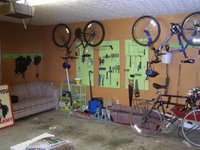 I met with my realtor today, and I have a buyer for my house. If all goes well, this means my house will be sold on April 25th. So I need to get the Dart moved - soon. Here is a picture of the work in progress on the garage that will be its new home while I finish the EFI work and get it running. Kelly and I have been making progress at sorting out the tools and getting the garage ready to accomodate two cars - her Nissan and my Dart. It will be a welcome change to be able to work on the Dart indoors, finally. And to have those handy pegboards that you see on the back wall to store my tools.
I met with my realtor today, and I have a buyer for my house. If all goes well, this means my house will be sold on April 25th. So I need to get the Dart moved - soon. Here is a picture of the work in progress on the garage that will be its new home while I finish the EFI work and get it running. Kelly and I have been making progress at sorting out the tools and getting the garage ready to accomodate two cars - her Nissan and my Dart. It will be a welcome change to be able to work on the Dart indoors, finally. And to have those handy pegboards that you see on the back wall to store my tools.Labels: Dodge Dart
Monday, April 10, 2006
Signs of a Bogus Mileage Gadget
Gas prices seem to have gone up a lot recently for no good reason. This almost always seems to mean that on the Internet, there will be a lot of talk about gadgets that claim they can increase gas mileage without a good reason. There are quite a few con artists who have sold devices they claim will improve gas mileage that just plain don't work and are sold at incredible markups. Some of them have even made it into your corner auto parts store. Here are three tips that you might be dealing with a bogus mileage gadget.
1. Baloney Operating Principle.
While a few mileage rip-offs claim to work on theories that have real scientific merit, most rip-off devices claim that they work due to reasons that can be boiled down to one of two principles. And both of these operating principles are total baloney.
The first example of baloney is what I call the "Your engine doesn't burn all the gasoline" principle. These claim that for whatever reason - the usual being that not all the gasoline vaporizes - the typical engine has problems with "incomplete combustion" and that some of the gasoline either doesn't burn and goes straight out the tailpipe, or possibly burns in the exhaust system. If you can get all the gasoline to burn in the combustion chamber, proponents claim, you'll get a lot more gas mileage and more power.
Well, the truth is that somewhere between 97% and 99% of the gasoline actually does burn in the combustion chamber. This has been explained at length on such sites as
The Straight Dope and Tony's Guide to Fuel Saving. At most, you might gain a bit of improvement in a carbureted car before the engine warms up. That is one case where you actually do have incomplete combustion and the fuel doesn't vaporize well, but you won't have this problem on any car built in the last 15 years or so.
There are a fair number of people and companies that perpetuate this myth that an engine doesn't burn a substantial amount of its fuel. Methods that claim to make use of this baloney principle include the Tornado and its kin, acetone as a fuel additive, chemicals that add "catalysts" to the fuel to promote complete combustion, and vapor carburetors.
The second bit of common baloney is what I call the "something for nothing" principle. This one is easy to spot. The con artists who hawk these things claim that there is something that will give your gasoline considerably more energy merely by placing it near the fuel. This something, whatever it is, does not take external power and does not release any chemicals into the fuel. It just, through some intangible means, does something to the fuel that makes it release more energy when it burns.
This, of course, violates the basic principles of thermodynamics. To get more energy out of the gasoline, you would have to put some sort of energy into it. A device that merely exposes gasoline to a magntic field, or something similar (my favorite example is the one that claimed to use "photons" even though it was supposed to be attached to the outside of a gas tank), isn't going to add energy to your gasoline.
I have seen some dubious mileage devices that claim to use other principles - both real and baloney - for how they work. The above examples are just what I have found to be the most common.
2. Misused Terminology.
Many rip-offs use words that come from the world of performance cars. Or rather, they abuse these words. One well-known product claims to "supercharge any car." Well, a supercharger is a power-driven pump or compressor that forces more air into an engine. This particular device is not a pump, and does not force more air into the engine. Another prime example is the collection of "chips" marketed on eBay. These devices are actually not chips, but resistors. If you catch a promoter using a name or slogan that implies their device is a version of a well-known type of performance product, and it isn't, you are probably dealing with a bogus gadget.
3. Zero Street Cred.
If you go to a message board full of gearheads - or attend a car club meeting - most of the people there will have heard of bogus mileage gadgets. And if you ask about them, they'll probably laugh - at the gadget's claims, not necessarily at you. On occasion, you may find a forum or club where someone has managed to hoodwink all the members about a particular device, particularly if the members are mostly inexperienced. But usually a bogus gadget will get no respect from serious car guys.
1. Baloney Operating Principle.
While a few mileage rip-offs claim to work on theories that have real scientific merit, most rip-off devices claim that they work due to reasons that can be boiled down to one of two principles. And both of these operating principles are total baloney.
The first example of baloney is what I call the "Your engine doesn't burn all the gasoline" principle. These claim that for whatever reason - the usual being that not all the gasoline vaporizes - the typical engine has problems with "incomplete combustion" and that some of the gasoline either doesn't burn and goes straight out the tailpipe, or possibly burns in the exhaust system. If you can get all the gasoline to burn in the combustion chamber, proponents claim, you'll get a lot more gas mileage and more power.
Well, the truth is that somewhere between 97% and 99% of the gasoline actually does burn in the combustion chamber. This has been explained at length on such sites as
The Straight Dope and Tony's Guide to Fuel Saving. At most, you might gain a bit of improvement in a carbureted car before the engine warms up. That is one case where you actually do have incomplete combustion and the fuel doesn't vaporize well, but you won't have this problem on any car built in the last 15 years or so.
There are a fair number of people and companies that perpetuate this myth that an engine doesn't burn a substantial amount of its fuel. Methods that claim to make use of this baloney principle include the Tornado and its kin, acetone as a fuel additive, chemicals that add "catalysts" to the fuel to promote complete combustion, and vapor carburetors.
The second bit of common baloney is what I call the "something for nothing" principle. This one is easy to spot. The con artists who hawk these things claim that there is something that will give your gasoline considerably more energy merely by placing it near the fuel. This something, whatever it is, does not take external power and does not release any chemicals into the fuel. It just, through some intangible means, does something to the fuel that makes it release more energy when it burns.
This, of course, violates the basic principles of thermodynamics. To get more energy out of the gasoline, you would have to put some sort of energy into it. A device that merely exposes gasoline to a magntic field, or something similar (my favorite example is the one that claimed to use "photons" even though it was supposed to be attached to the outside of a gas tank), isn't going to add energy to your gasoline.
I have seen some dubious mileage devices that claim to use other principles - both real and baloney - for how they work. The above examples are just what I have found to be the most common.
2. Misused Terminology.
Many rip-offs use words that come from the world of performance cars. Or rather, they abuse these words. One well-known product claims to "supercharge any car." Well, a supercharger is a power-driven pump or compressor that forces more air into an engine. This particular device is not a pump, and does not force more air into the engine. Another prime example is the collection of "chips" marketed on eBay. These devices are actually not chips, but resistors. If you catch a promoter using a name or slogan that implies their device is a version of a well-known type of performance product, and it isn't, you are probably dealing with a bogus gadget.
3. Zero Street Cred.
If you go to a message board full of gearheads - or attend a car club meeting - most of the people there will have heard of bogus mileage gadgets. And if you ask about them, they'll probably laugh - at the gadget's claims, not necessarily at you. On occasion, you may find a forum or club where someone has managed to hoodwink all the members about a particular device, particularly if the members are mostly inexperienced. But usually a bogus gadget will get no respect from serious car guys.
Saturday, April 08, 2006
Interesting link - a Lucas oil test
You've seen it in auto parts stores. A plastic box of gears, with one side lubricated by normal oil and the other demonstrating Lucas Oil Stabilizer. The Lucas stuff apparently changes the surface tension of the oil, allowing it to climb up the gears and deliver more lubrication to the top gear. Bob the Oil Guy decided to put the Lucas oil to the test. He found that it does, indeed, help oil climb gears. Unfortunately, it has a potentially damaging side effect: It also causes the oil to foam and bubble at high speeds. This isn't too noticable in store displays, since you can't turn the crank as fast as your engine can turn. But foam and bubbles aren't too good for lubricating your engine. You can see the results at his Lucas Oil Test Page.
Saturday, April 01, 2006
Covington Car Show
The Southern Cruisers hold a car show at Covington Square on the first Saturday of the month in the spring, summer, and fall. My wife and I went to see this one, stopping in at A Touch of Country for Hazard County Floats (that's orange sherbet in Sprite). Here are some pictures we took.
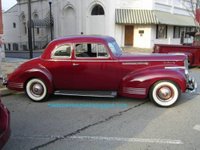

A nice old Pacard and its interior
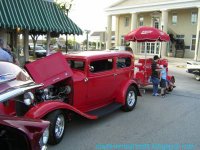
This street rod towed a Coke stand on a trailer.

A rare Chevelle Laguna S3.

This VW had been converted into a jacked-up off roader with Chevy power. Easily the strangest car at the show.

An Aspen R/T, another '70s rarity.

That big nitrous bottle on that Camaro sure looks impressive...

...but we couldn't find any sign of a nitrous system under the hood. A work in progress, some sort of perverse sleeper with a hidden system, a poser, or an April Fools' Day joke? You decide.


A rat rod with classic Olds power.
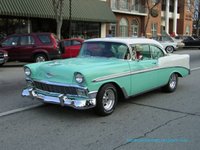


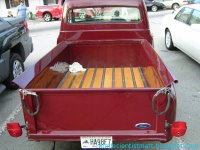

And some other noteworthy cars that showed up.


A nice old Pacard and its interior

This street rod towed a Coke stand on a trailer.

A rare Chevelle Laguna S3.

This VW had been converted into a jacked-up off roader with Chevy power. Easily the strangest car at the show.

An Aspen R/T, another '70s rarity.

That big nitrous bottle on that Camaro sure looks impressive...

...but we couldn't find any sign of a nitrous system under the hood. A work in progress, some sort of perverse sleeper with a hidden system, a poser, or an April Fools' Day joke? You decide.


A rat rod with classic Olds power.





And some other noteworthy cars that showed up.
A garage project picture

My wife and I spent a lot of time today getting the garage painted. She's wanted a nice distinctive garage since we began dating, but until recently my brother-in-law had been storing things in it while his house was built. We've decided to get things all complete before I bring in my Dodge Dart, so we can work on the garage with no cars to get in the way. The wood on the back wall is to hold up a set of pegboards, painted a bright green to match the rack you can see by the window. It won't be long before this project is done!

